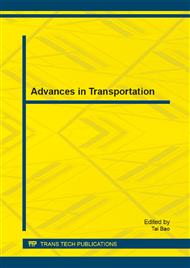p.121
p.125
p.129
p.134
p.139
p.149
p.154
p.163
p.168
Effects of Framed Embankment for High-Grade Expressway in Permafrost Regions
Abstract:
Construction of high-grade highways is an important action to meet the requirement of communication and transportation in permafrost regions. Frame embankment is proposed to reduce the scale effects caused by wide pavement. Numerical simulation method is employed to analyze the improvement of frame embankment for thermal stability of roadbed, with the consideration of global warming. Compared the response of permafrost at symmetric position of each embankment to construction, the consistency degree of response is taken as decision fundament. Two indexes are selected, that is, the difference of permafrost table between the embankment and that at natural side, and the change of mean annual geothermal under the embankment. Additionally, the convenient for construction and wind-blown sand hazard are considered to determine reasonable frame space. So, numerical simulation of flow field of wind around embankments is carried out. It is concluded that the minimum space between two embankment is 6 m. The aim of this study is to provide scientific guidelines on construction of major permafrost engineering in the future.
Info:
Periodical:
Pages:
139-148
Citation:
Online since:
January 2014
Authors:
Price:
Сopyright:
© 2014 Trans Tech Publications Ltd. All Rights Reserved
Share:
Citation:


